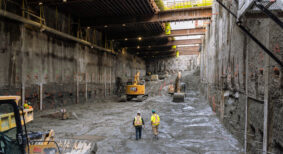On January 24, 2024, the BC Court of Appeal illuminated the intricate landscape of liability for negligence in construction projects in the decision of Centurion Apartment Properties Limited Partnership v. Sorenson Trilogy Engineering Ltd., 2024 BCCA 25. This case involves a 11-storey 90-unit concrete apartment building in Langford, B.C., which faced evacuation post-occupancy due to severe structural deficiencies jeopardizing resident safety.
Background
The action was commenced by related entities (collectively, Centurion) that are part of a real estate investment trust and the current legal and beneficial owners of the building at issue.
Centurion purchased the building in April 2019 from the original owner-developer by acquiring the shares of the company holding legal title to the land and building.
The contractual matrix for the design and construction of the building involved the owner-developer retaining a designer-builder, DB Services Victoria Inc. (DB), which in turn retained structural engineers, Sorensen Trilogy Engineering Ltd. (engineers), as consultants on the project.
The contracts between the parties contained clauses allocating and limiting liability. The contract between DB and the engineers limited the structural engineers’ liability, “whether in contract or tort”, to the fees paid to the engineers for their services on the project, which amounted to $88,775. The contract between the owner-developer and DB was a standard form CCDC14 – Design-Build Stipulated Price Contract, which stated that there was no contractual relationship between the owner-developer and the engineers, allocated liability for acts and omissions of the engineers to DB, and limited the extent of DB’s liability to the $1 million of insurance it was required to carry.
After the building was occupied, Centurion became aware of serious deficiencies in design and structural integrity, following investigations by Engineers & Geoscientists of British Columbia (EGBC) and the City of Langford which resulted in the city revoking the occupancy permit, requiring the building to be evacuated and the residents to be relocated to a hotel. The EGBC had received a complaint which ultimately led to the determination that the building did not meet certain requirements of the code and resulted in citations against the engineer of record and principal of the firm for accepting a retainer despite lack of the requisite expertise, unprofessional conduct, and incompetence.
BC Supreme Court
Centurion sought recovery for damages arising from negligence in design and construction of the building from the engineers. The engineers applied to summarily dismiss the claim for negligence arguing that there was no relationship of proximity sufficient to establish a duty of care. The court sided with the engineers and held that the freely negotiated contractual arrangements between sophisticated parties expressly addressed and allocated risk, therefore negating any relationship of proximity and altering the duty of care that would otherwise be owed by the engineers to the owners. Accordingly, the owners could not circumvent the contractual arrangements by pursuing a claim in tort. The court also upheld the limitation of liability clause, restricting the engineers’ liability to the fees paid for their services.
BC Court of Appeal
In a pivotal reversal, the Court of Appeal challenged the lower court reliance on the parties’ contractual matrices without considering the true nature of the risk, distinguishing between cases shoddy or substandard workmanship from dangerously defective work. It affirmed that a duty of care does arise between a supplier of goods and a subsequent purchaser if the defective goods present a risk of real and substantial danger necessitating repair. That is, the engineers had a duty, independent of any contractual stipulation, to take reasonable care in designing and constructing the building to ensure that it did not contain defects that pose foreseeable and substantial danger to the health and safety of occupants. Given the parties’ expectations, the foreseeable reliance on the professional competence of the engineers, and public policy concerns, it would not be just and fair for the contractual arrangement to eliminate a duty of care in tort.
With respect to the clause limiting the engineers’ liability to the fees charged, the Court of Appeal set aside the lower court reasoning and expressed reservations about determining whether such a clause was unconscionable summarily, emphasizing the need for weighing the factual matrix and assessing allegations of fraud and misrepresentation against the engineers at trial to determine validity or enforceability of the limitation clause.
Takeaways
This decision underscores that corporate structures and contractual arrangements between parties in the construction chain do not operate to completely absolve liability under the law of negligence when the nature of the risk rises to the level of real and substantial danger.
This will serve as a cautionary tale reminding construction participants to broaden their outlook with respect to consequences of any acts or omissions beyond contractual obligations by considering potential impact on the expectations, reliance, safety, and interests of other stakeholders.
The Court of Appeal’s refusal to allow contracts to be used as shields against justified claims emphasizes the policy rationale for holding parties accountable for foreseeable consequences of breaches of duties that carry potential for significant risk of harm.
The appeal decision leaves the door open for owners seeking to advance claims for pure economic loss against parties in construction projects with whom no direct contractual relationship exists when sufficient proximity can be established giving rise to a duty of care.
Iman Hosseini is an associate at Alexander Holburn Beaudin + Lang LLP. He is a member of the firm’s Construction + Engineering, Business Disputes, Labour + Employment, Corporate/Commercial, and Wills, Estates + Trusts practice groups.









